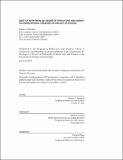Best of both worlds : issues of structure and agency in computational creation, in and out of school
Author(s)
Brennan, Karen A. (Karen Ann)
DownloadFull printable version (9.384Mb)
Alternative title
Issues of structure and agency in computational creation, in and out of school
Other Contributors
Massachusetts Institute of Technology. Department of Architecture. Program in Media Arts and Sciences.
Advisor
Mitchel Resnick.
Terms of use
Metadata
Show full item recordAbstract
We live in a computational culture - a culture in which we are surrounded by computational systems and interfaces, from social networks to banking infrastructure, to entertainment platforms, to transportation systems. This culture introduces new expectations and new opportunities for learning, creating new demands for what to learn and offering new possibilities for how to learn. In this dissertation, I adopt a predominantly qualitative approach to exploring learning in computational culture, studying how the Scratch programming environment and online community are employed to support learning both in and out of school. To this end, I conducted interviews with 30 kids working with Scratch at home and 30 teachers working with Scratch in K-12 classrooms to develop descriptions of computational creation in these two settings. Using a theoretical framework of agency and structure, I analyze how the at-home and school-classroom contexts enable - or constrain - young people's agency in computational creation. Despite common assumptions that at-home learning is necessarily low-structure/high-agency and that at-school learning is necessarily high-structure/low-agency, I argue that structure and agency need not be in opposition. Designers of learning environments should explore intermediate possibilities, finding ways to employ structure in the service of learner agency.
Description
Thesis (Ph. D.)--Massachusetts Institute of Technology, School of Architecture and Planning, Program in Media Arts and Sciences, February 2013. This electronic version was submitted by the student author. The certified thesis is available in the Institute Archives and Special Collections. Cataloged from student-submitted PDF version of thesis. "February 2013." Includes bibliographical references (p. 209-219).
Date issued
2013Department
Program in Media Arts and Sciences (Massachusetts Institute of Technology)Publisher
Massachusetts Institute of Technology
Keywords
Architecture. Program in Media Arts and Sciences.